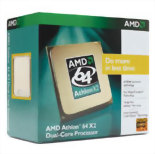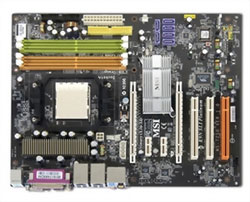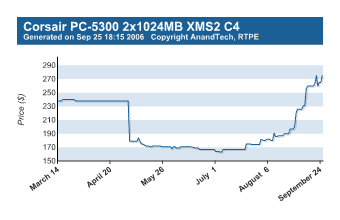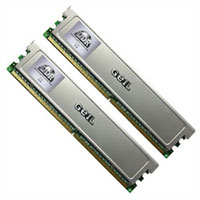Baseline AMD Midrange Platform
For several years, virtually every single one of our buyer's guides has come out with the statement that AMD is the preferred platform for price/performance over Intel. This was simply a matter of choosing the best platform, which has been AMD's K8 processor architecture for about three years. Unfortunately for AMD proponents, this is no longer the case. Simply put, Intel has crushed one out of the ballpark with the launch of the Core 2 platform. If you are looking for faster processor performance, with very few exceptions Intel now holds the lead. The good news is that the AMD platform still has a couple points in its favor. We will get into those shortly, but let's start with the baseline AMD recommendations.
 |
With prices being what they are, there's absolutely no reason to consider anything other than a dual core processor these days for a midrange computer. Not everyone is going to make full use of both processor cores, but even in everyday computer use the dual core systems feel more responsive and multitask better, and we only expect the gap between single core and multi-core configurations to widen in the future. That doesn't mean you need to go out and purchase the fastest dual core processor you can find, and in fact we have gone with the slowest Athlon X2 currently available, the 3800+ for socket AM2. Clocked at 2.0 GHz and sporting 512K of L2 cache, the 3800+ used to cost over $300 just a few months ago. With the price now cut in half, there's a whole lot to like. Overclocking capabilities are still good, and it should be pretty easy to run the 3800+ at 2.5 GHz if that's what you're after. Most people don't run a lot of CPU limited applications, so upgrading to a faster processor shouldn't be your first move unless you specifically run tasks that will benefit.
 |
The biggest advantage of the AM2 platform is undoubtedly in the area of motherboards. Prices are so low on reasonable motherboards that we feel there is little reason to get anything other than a board that supports either SLI or CrossFire, at least in the midrange price segment. You may not need the second X16 slot initially, and perhaps it will never get used, but the cost of adding the second slot is only about $20, and you often get better features along with the additional PEG slot. We feel the best overall choice for midrange AM2 motherboards is the nForce 570 SLI chipset. Performance nearly matches the more expensive nForce 590 SLI offerings but at a significantly lower price. Doubling the PCI-E bandwidth sounds good in theory, but the reality is that very few tasks are truly bandwidth starved from the PCI-E bus.
Having decided on a chipset, the overwhelming favorite motherboard using this chipset would be the EPoX 570 SLI. If you can find one in stock at a reasonable price, that would be our primary choice, but at present most online retailers are on back order. A very good alternative is the MSI 570 K9N SLI Platinum, which still overclocks reasonably well. It also costs less than the EPoX board and it comes with FireWire support. The Northbridge heatsink can get quite hot without some form of active cooling nearby, but in a properly ventilated case with a typical CPU HSF, it shouldn't present any problems.
The one area that is an absolute shock after the last midrange guide is the choice of DDR2 memory. A few months ago, it was possible to find 2x1024MB of reasonable quality DDR2 memory for under $150. At present, prices are up over $50 across the board. The situation is illustrated nicely by this price graph of the Corsair PC2-5300 C4 memory. If you browse through the DDR2 section of our
Real Time Price Engine, you will see this same type of graph again and again. Unfortunately, all we can do for now is hope that prices will drop, but anyone looking to purchase memory right now will simply have to bite the bullet. Thankfully, the GEIL PC-5300 2x1024MB Value memory that we selected performs very well. While it is rated at DDR2-667 5-5-5-15, we have found in testing that it will run at 4-4-4-10 with 1.95V at DDR2-667, 4-4-4-12 at DDR2-800 with 2.1V, and 5-5-5-15 at DDR2-900 with 2.3V. The integrated memory controller of the AM2 platform makes memory bandwidth less of a concern, but it is still nice to get memory that can run at DDR2-800 if you want to do some overclocking.
 |
Choosing a good midrange video card really isn't too difficult, provided you know the intended use. For our baseline midrange configuration, we are going off the assumption that gaming isn't a primary concern. Taking a quick look at the $100-$125 GPU market, the NVIDIA GeForce 7600 GS comes out as the overall best performance and value. More importantly, the Gigabyte card received our editor's choice in the
silent GPU roundup last month. This card consistently outperformed the other silent offerings, and it even manages to do so at a lower price than many of its direct competitors. Windows Vista will make GPUs more important for general use, so we don't feel that any new midrange system should go any lower than the 7600 GS. And even if we say that gaming isn't a primary concern, the 7600 GS is still able to handle most current games at moderate detail settings.
We will leave discussion of the remaining baseline component choices for the next page where we cover the Intel baseline platform, as the only difference between our AMD and Intel choices are in the motherboard and processor departments. If you're looking for other alternatives, however, we do have a few suggestions.
We already mentioned the Epox 570 SLI motherboard, but if you are absolutely certain you don't want the second X16 PCI-E slot, the DFI Infinity NF4 Ultra2-M2 is getting a great reputation as an overclocking king and it is $95 now. It is based on the nForce4 chipset but it still works with socket AM2. Really, the difference in performance between nForce4 and nForce 5 is negligible for most applications, and the DFI Ultra2-M2 is absolutely rock solid when it comes to stability.
Alternatives for the memory are easy to find, although we would stick with DDR2-667 or faster memory. All of the major manufacturers have reasonable products, and right now price is going to be a in determining which RAM to buy. A-DATA, Corsair, Crucial, G.Skill, Kingston, OCZ, PDP, PQI, and others are worth considering, and you might also want to check out the
Value DDR2 section of the Conroe Buying Guide for more information. Gamers will probably want a faster graphics card, and we recommend looking at our upgraded configuration for more information on faster graphics cards. What about 2x512MB of RAM instead of the full 2GB? Windows Vista is really going to tax 1GB systems, and we feel strongly that any midrange PC should be viable without upgrades for at least the next year. We feel you are truly going to regret going with anything less than 2GB of memory in the near future, and we only recommend 1GB configurations for entry level computing these days.
















49 Comments
View All Comments
JarredWalton - Wednesday, September 27, 2006 - link
1600x1200 is nice, but it's about the same total pixel number as 1680x1050 (a bit more) and it costs more. I would personally take the Acer 22" WS over 1600x1200 - widescreen looks awesome. If you prefer not to have to deal with getting WS resolutions to work, though, 1600x1200 is probably the best way to go for LCDs.Revolutionary - Wednesday, September 27, 2006 - link
Having just built a system based on the 965P-S3, I want to make 2 comments:First, OCZ Platinum 6400 DOES NOT WORK in this motherboard. Its a known conflict not fixed by the F4 Bios. Do some searching in the forums and on Google.
As for the difference between the S3 and the DS3: the singular difference is solid-state vs. fluid capacitors. There is no difference in overclocking performance; the solid state capacitors have a longer life-expectancy. Not even Gigabyte claims that the DS3 will OC better. Again, Google around a bit to see for yourself.
JarredWalton - Wednesday, September 27, 2006 - link
I have talked with to Gary Key, and the following is information from him as well as my own comments:The DS3 is doing around 510 in our testing, while we got around 460 stable on the S3. We've seen reports of up to 480 on it. The caps make a huge difference in overclocking as they run cooler, allowing higher clocks and additional stability.
And he has had no issues with running the OCZ Platinum Rev. 2 DDR2-800. There is a big difference between RAM not working, and RAM not working when you simply run everything at default settings. The OCZ RAM does like more voltage than stock. It is rated at 4-4-4-15 2.2V DDR2-800, and while it may run fine at 1.8V 4-4-4-15 in some circumstances, it is designed to run with higher voltages.
Unfortunately, just doing a Google on information doesn't mean the information is accurate. Any monkey with a keyboard and an internet connection can post content to the internet, but we don't know if they really have a clue what they're doing. A beginner that can't get OCZ + S3 to run properly because they assume "Auto/SPD" should just work fine will blast both products. High-end enthusiast RAM often requires special considerations like bumping the voltage level up to 2.0-2.2V. We even posted appropriate settings, though:
"The OCZ 2x1024MB PC2-6400 Platinum Revision 2 ran at 4-4-3-10 with 2.2V at up to DDR2-900, 5-4-4-12 at DDR2-1000 with 2.3V, and topped out at about DDR2-1033 at 5-5-5-12 with 2.3V."
And the OCZ RAM is generally out of stock right now. You can try the G.Skill RAM which performs about the same. It costs a bit more, however:
http://www.newegg.com/Product/Product.asp?Item=N82...">G.Skill DDR2-800 Note that the G.Skill will also require more voltage than 1.8V (or even 1.9V), and in testing it will generally run about the same as the OCZ Platinum 2.
Sunrise089 - Tuesday, September 26, 2006 - link
Although the Anandtech forums can be usefull for this sort of info, I always enjoy seeing a new system price guide, and find them one of the most usefull parts of the site. I'm not sure how sustainable one guide every two weeks will be (are you guys going to stop making the individual part guides since system guides will come out so often?) but if you can make it work then great. One thing I would love to see however is budget, midrange, high-end, and overclocking guides. I think the fourth category has at least as many followers as the high-end segment, and it might make your midrance guide quicker to write, since you could ignore overclocking performance.JarredWalton - Tuesday, September 26, 2006 - link
I find it difficult *not* to talk about OC'ing, but I suppose I could try and then move that into a separate guide. Hmmm.... If we have the price guides up and running again, I may cut it down a bit, but for now system component prices are changing enough that every other week is pretty sustainable.Sunrise089 - Wednesday, September 27, 2006 - link
One of the specific reasons I would prefer a seperate OC'ing guide is because while I might build a PC exactly as described in the midrange guide if I were building it for a family member, I would have to make several additional decisions if I were buying it for myself and wanted to overclock. In an overclocking PC I would want to add an aftermarket HSF, maybe consider a different PSU, and be much more interested in specific OC'ing performance in the memory and motherboard. Although it's nice to see that at X23800+ or a Core2Duo6600 can overclock, if the guide doesn't tell me what additional choices I need to make in order to take advantage of the overclocking headroom then it isn't really serving as a "buyer's guide" to the overclocking user. Therefore it seems a good idea to me to add the specific guide for overclocking in order to allow for overclocking specific reccomendations.yacoub - Tuesday, September 26, 2006 - link
Most of us can do a LOT better for the money because we won't need to buy a new case, keyboard, mouse, display, harddrive, optical dive, etc. Most folks will only need to upgrade the motherboard, RAM, and CPU. Some also their GPU.So if you estimate $200 for a CPU, $200 for a motherboard, and $250 for RAM, you're looking at under $700 for an upgrade to the latest and greatest.
Murst - Tuesday, September 26, 2006 - link
I think you miss the point of this review.Chances are, if you're upgrading your system, then yes, you will be upgrading certain parts. However, even if you're upgrading certain parts, your post seems rather strange. Most people will probably consider upgrading the gfx card before upgrading the cpu/mb/ram. Also, if you upgrade your mb, chances are that it is not pci-e so you will have to upgrade your sound card as well. But I guess that all depends on how often you upgrade (I'm thinking of a 2 year cycle from what I do)
But anyways, this review is about what type of system you can build for 1-1.5k. It is not about what part Joe can put into his own computer to make it faster, althogh some of us certainly look at their recomendations when we do choose to upgrade specific parts.
yacoub - Tuesday, September 26, 2006 - link
I guess you missed my point. I wasn't critiquing the review, just adding a note related to it. A lot of folks probably run s939 boards right now, and may have even already picked up a cheap X2 dual-core CPU recently so they are obviously going to focus their next upgrade on GPU.Other folks here are running s754 or similar generation Intel setups that were 1st gen PCI-E and not dual-core compatible, and probably have recently upgraded to a good GPU but are looking to upgrade their system core (cpu, mobo, and RAM) soon since that will be significant for them.
The second group is who I was talking about.
As far as audio cards, my X-Plosion 7.1 DTS should work fine for a while, as most boards have at least one PCI slot.
RamIt - Tuesday, September 26, 2006 - link
"The Gigabyte GA-965P-S3 first showed up in our labs as a pretty mediocre offering, but with the latest BIOS updates it has turned into a real gem. The Gigabyte DS3 will still overclock a bit better in terms of maximum bus speed"What gives? The s3 and the ds3 are the basicly the same motherboard with almost identical bioses with the exclusion of the caps. How could the ds3 clock better than the s3?